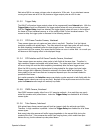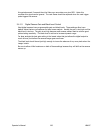Note: Do not confuse this type of integration control with features on high-end digital cameras that have externally
programmable integration controls. These later types of cameras are programmed by issuing serial commands to
the camera’s internal microprocessor. See section 5.4 for a discussion of these types of cameras.
5.3.1 Integration Operation
The Integration control is found in the Options, Capture, dialog box. If you purchased a digital
camera from Spiricon that is compatible with external integration capabilities, then the Integration
edit control will become operational when the matching camera type has been selected. The Spiricon
supplied camera power cable will have the integration circuits prewired into the cable.
The only thing required to enable multiple frame integration is to set the Integration value to a
number greater than 1. This number represents the number of frame periods that the camera will
use for each frame of output video.
5.4 Digital Camera Operations
The largest growing segment of the camera market involves a rapid increase in the numbers and types
of digital cameras available for both commercial and scientific uses. As a result, most of our recent
efforts in camera testing and evaluating have involved digital cameras. Most all RS-422 and RS-644
(LVDS) digital cameras can be interfaced to any of Spiricon’s new LBA-7XXPC-D (digital option) frame
grabbers. The only major limitation has to do with the size of the image that can be captured. This
limitation is impacted by the throughput of the frame grabber and the pixel clock and video frame
format of the camera. In most cases this impact is limited to a reduction in the frame size or frame
resolution that can be reliably acquired from the camera. The Spiricon supplied camera configuration
files will take these limitations into account and will adjust the image size or resolution to insure stable
operation.
The following section will discuss some of the operating features often seen in modern digital cameras
and how those features may or may not be used with the LBA-PC software.
5.4.1 Digital Camera Control
Digital cameras often have a large number of control features. The number and methods for
controlling these features varies greatly from one manufacturer to another. The basic control
methods fall into two categories. The oldest control method employs switches and dials located on
the outside and inside of the camera. More modern designs employ micro-processors inside the
camera that can control the operations via serial commands issued from your PC’s serial port. The
manufactures of these cameras usually provide a camera control console application that must be run
on your PC. A few manufactures require you to write your own control application. Some cameras
have simple command protocols and can be controlled by typing commands into a simple terminal
emulator program like Windows Hyper Terminal.Most digital cameras will power up in a default mode
of operation. Some can have the default mode changed by the user. Others will always start
operating in one mode and the user must change it to the desired configuration every time power is
restored. The LBA-PC camera files are very specific to how certain of these features are configured.
The camera file name will often include a reference to a critical feature. Most often these critical
settings concern the image format of the camera.
5.4.1.1 Digital Camera Binning Effects
Many digital cameras support electronic pixel binning. This feature is usually used to increase
the frame rate of the camera by decreasing the total number of pixels in the image. If a camera
Operator’s Manual LBA-PC
124


















